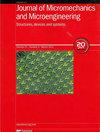用于人机界面应用的压电和三电自供电传感器的最新进展
IF 2.4
4区 工程技术
Q2 ENGINEERING, ELECTRICAL & ELECTRONIC
引用次数: 0
摘要
蓬勃发展的物联网(IoTs)和人工智能(AI)技术繁荣了各种新兴应用。例如,人机界面(HMI)能够让用户以直观、高效和友好的方式与机器进行交互,并能够即时获取、处理、交流和反馈信息等。这些功能需要超紧凑、高性能的传感器,因此自供电传感器已成为人机界面应用的关键基础技术。本综述重点关注压电式、三电式和混合式自供电传感器,尤其关注其微结构和制造方法,表明传统的微制造方法和新兴的制造方法,如三维(3D)打印、电纺丝和编织,对平面型、阵列型、多孔型、织物型和复合型自供电传感器做出了贡献。此外,还研究了压电和三电传感器阵列(TSA)的集成方法。重点讨论了串扰问题,即相邻传感单元之间的信号干扰,并通过具体实例回顾了当前的解决方案,如阵列设计优化、信号处理改进和材料创新,以降低串扰灵敏度。报告概述了三类人机界面应用,包括智能交互、机器人和人体监测,并详细解释了自供电传感器如何支持这些人机界面应用。通过对挑战和前景的讨论,提出进一步协调微型设备与人机界面的设计和制造,将有可能促进智能应用的多样化、便利性和互联性更上一层楼。本文章由计算机程序翻译,如有差异,请以英文原文为准。
Recent advances in piezoelectric and triboelectric self-powered sensors for human-machine interface applications
The burgeoning internet of things (IoTs) and artificial intelligence (AI) technologies have prospered a variety of emerging applications. Human-machine interfaces (HMIs), for instance, enables users with intuitive, efficient, and friendly way to interact with machines, capable of instant information acquisition, processing, communication, and feedback, etc. These features require ultra-compact and high-performance transducers, and therefore self-powered sensors have become the key underlying technology for HMI applications. This review focuses on the piezoelectric, triboelectric, and hybrid self-powered sensors with particular attention to their microstructures and fabrication methods, showing that both traditional microfabrication and emerging fabrication methods like three-dimensional (3D) printing, electrospinning, and braiding have contributed to the planar, array, porous, fabric, and composite type self-powered sensors. Moreover, the integration method of piezoelectric and triboelectric sensor arrays (TSAs) is investigated. The crosstalk issue is highlighted, i.e. the signal interference between adjacent sensing units, and current solutions such as array design optimization, signal processing improvement, and material innovation to reduce crosstalk sensitivity have been reviewed through specific examples. Three categories of HMI applications have been outlined, including intelligent interaction, robotics, and human monitoring, with detailed explanations of how the self-powered sensors support these HMI applications. Through discussion of challenges and prospects, it is proposed that further coordinating the design and fabrication of micro devices with HMIs will potentially boost the intelligent application with even higher level of diversification, convenience, and interconnectivity.
求助全文
通过发布文献求助,成功后即可免费获取论文全文。
去求助
来源期刊

Journal of Micromechanics and Microengineering
工程技术-材料科学:综合
CiteScore
4.50
自引率
4.30%
发文量
136
审稿时长
2.8 months
期刊介绍:
Journal of Micromechanics and Microengineering (JMM) primarily covers experimental work, however relevant modelling papers are considered where supported by experimental data.
The journal is focussed on all aspects of:
-nano- and micro- mechanical systems
-nano- and micro- electomechanical systems
-nano- and micro- electrical and mechatronic systems
-nano- and micro- engineering
-nano- and micro- scale science
Please note that we do not publish materials papers with no obvious application or link to nano- or micro-engineering.
Below are some examples of the topics that are included within the scope of the journal:
-MEMS and NEMS:
Including sensors, optical MEMS/NEMS, RF MEMS/NEMS, etc.
-Fabrication techniques and manufacturing:
Including micromachining, etching, lithography, deposition, patterning, self-assembly, 3d printing, inkjet printing.
-Packaging and Integration technologies.
-Materials, testing, and reliability.
-Micro- and nano-fluidics:
Including optofluidics, acoustofluidics, droplets, microreactors, organ-on-a-chip.
-Lab-on-a-chip and micro- and nano-total analysis systems.
-Biomedical systems and devices:
Including bio MEMS, biosensors, assays, organ-on-a-chip, drug delivery, cells, biointerfaces.
-Energy and power:
Including power MEMS/NEMS, energy harvesters, actuators, microbatteries.
-Electronics:
Including flexible electronics, wearable electronics, interface electronics.
-Optical systems.
-Robotics.
 求助内容:
求助内容: 应助结果提醒方式:
应助结果提醒方式:


